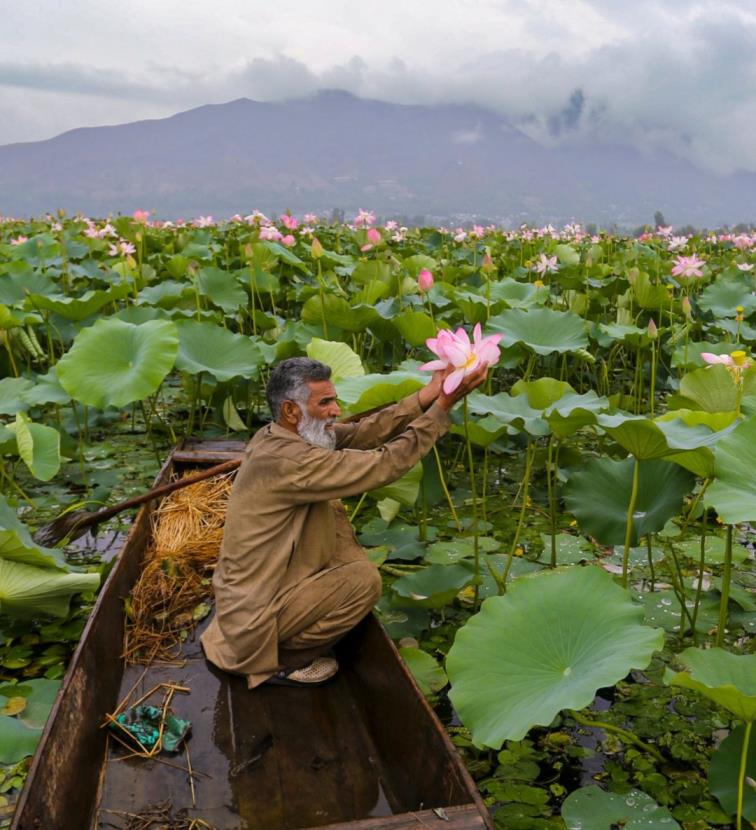Lotus beds reappear in Wular Lake after 3 decades

Jul 12, 2025
BANDIPORA: After nearly three decades, the lotus has bloomed once again in the Wular Lake in north Kashmir - the second largest fresh-water lake in Asia - thanks to conservation efforts after the devastating floods in 1992 had wreaked havoc with its rich ecosystem.
A sea of pink lotuses -- not just crucial for ecology but for the livlihoods of locals -- can be seen in a part of the lake, which is spread in a total area of 200 square km, covering almost 24 km in length, stretching from the foothills of the Haramukh mountain range in the Bandipora district to Sopore town in the neighbouring Baramulla district.
"This is nothing short of a miracle," Abdul Hameed, a resident, said.
He said that earlier, the locals used to disperse the lotus seeds into the lake, but they achieved nothing. "It did not work. They could not grow because of silt," Hameed said Kashmir Valley witnessed a devastating flood in 1992 that caused damage to the rich ecosystem of Wular Lake, situated about 70 km from Jammu and Kashmir's summer capital Srinagar.
The flood deposited a large quantity of silt in the lake that buried the lotus vegetation over the years.
However, owing to the conservation efforts by Wular Conservation and Management Authority (WUCMA) - including desilting of the lake - in the last few years, the lotus beds have appeared once again.
"Last year, there were signs of revival of lotuses. Then this year, the WUCMA dispersed lotus seeds in the lake, and there was a bloom," said Mudasir Ahmad, an official of the lake authority.
Ahmad, who is the zonal officer at WUCMA, said the bloom has spread to nearly three sq km of the lake, and the turnaround was achieved by desilting the lake as part of the restoration of the water body.
Chief Conservator of Forests, Kashmir Division, Irfan Rasool, said the return of the lotus is a strong indicator of the improving ecological health of the lake, which had suffered significant degradation over decades, with heavily silted area reported up to 27 sq kms, impacting its water holding capacity, ecological functions and the livelihoods of communities.
He said WUCMA embarked on the major project by utilising Cutter Suction Dredgers.
Rasool said the project aimed to restore the critically silted-up area by undertaking dredging.
"As of July 2025, around 80 lakh cubic metres of silt has been cleared by WUCMA from Wular lake. By removing vast quantities of silt, the project has successfully restored nearly five sq km of the lake's area, significantly increasing its water holding capacity," he added.
The desilting initiative has been instrumental in restoring the lake's original depth and improving water flow, the official said.
Rasool said it restored sunlight penetration to the lake bed and revitalised conditions, allowing the dormant root structures of the lotus plant to regrow.
The return of lotuses has renewed hopes among the locals of harvesting their edible stems, known as ‘nadru' in local parlance.
The water body was once a major source of income for hundreds of families. ‘Nadru' is one of the popular delicacies in Kashmir, and its harvesting provided seasonal employment to many.
The harvesting involves diving neck deep into the water to retrieve the stem. "Nadru was non-existent in the lake for all these years," Ahmad said, adding that it can now be grown and harvested.
The economy of the local population would get a boost now, he said.
Hameed expressed gratitude to the WUCMA for the dredging undertaken in the lake, saying it contributed to the revival of the aquatic plant.
"It is all because of dredging and desilting that we are seeing lotuses blooming once again. This is a blessing from God," Hameed said.
He implored the people to safeguard the biodiversity of the lake and stop polluting it.
"We have to mend our ways now. It was taken away from us once, and if we do not change, it may be taken away again," he added.
And it is not just the comeback of lotuses. The increased water depth and improved water quality in the lake have also created a more hospitable environment for diverse aquatic flora and fauna, Rasool said.
"This ecological revival has thus contributed to attracting a greater variety of migratory birds, enhancing the lake's biodiversity," the chief conservator of forests said.
The rare migratory birds sighted in the lake in the last two years include Great Bittern, Long-tailed Duck, Falcated Duck, Horned Grebe, Western Reef Heron, Smew Duck, Pacific Golden Plover, Broad-billed Sandpiper, Marbled Teal, Pallas's Fish-eagle, Common Pochard, and Greylag Geese.